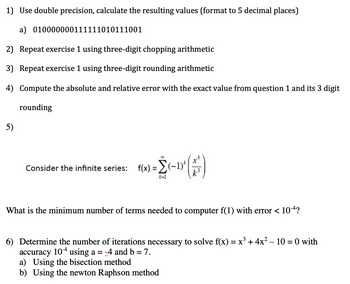
Database System Concepts
7th Edition
ISBN: 9780078022159
Author: Abraham Silberschatz Professor, Henry F. Korth, S. Sudarshan
Publisher: McGraw-Hill Education
expand_more
expand_more
format_list_bulleted
Question
thumb_up100%
Please help me solve these using python

Transcribed Image Text:1) Use double precision, calculate the resulting values (format to 5 decimal places)
a) 010000000111111010111001
2) Repeat exercise 1 using three-digit chopping arithmetic
3) Repeat exercise 1 using three-digit rounding arithmetic
4) Compute the absolute and relative error with the exact value from question 1 and its 3 digit
rounding
5)
f(x) = 2 (-1)^(1/²)
k=1
Consider the infinite series: f(x)=(-1)*|
What is the minimum number of terms needed to computer f(1) with error < 10-4?
6) Determine the number of iterations necessary to solve f(x) = x³ + 4x² − 10 = 0 with
accuracy 104 using a = -4 and b = 7.
a) Using the bisection method
b) Using the newton Raphson method
Expert Solution
This question has been solved!
Explore an expertly crafted, step-by-step solution for a thorough understanding of key concepts.
This is a popular solution
Trending nowThis is a popular solution!
Step by stepSolved in 2 steps

Follow-up Questions
Read through expert solutions to related follow-up questions below.
Follow-up Question
I'm getting this message when I try to use int(binary, 2) "leading zeros in decimal integer literals are not permitted; use an 0o prefix for octal integer". How can I fix this?
Solution
by Bartleby Expert
Follow-up Question
Can you post the code to solve these?
Solution
by Bartleby Expert
Follow-up Questions
Read through expert solutions to related follow-up questions below.
Follow-up Question
I'm getting this message when I try to use int(binary, 2) "leading zeros in decimal integer literals are not permitted; use an 0o prefix for octal integer". How can I fix this?
Solution
by Bartleby Expert
Follow-up Question
Can you post the code to solve these?
Solution
by Bartleby Expert
Knowledge Booster
Learn more about
Need a deep-dive on the concept behind this application? Look no further. Learn more about this topic, computer-science and related others by exploring similar questions and additional content below.Similar questions
- Wap in to make chess in python(using turtle library)arrow_forwardPython Help Write (1) the pseudo code, (2) the code, of the following problems: An online bank wants you to create a program that shows prospective customers how their deposits will grow. Your program should read the initial balance and the annual interest rate. Print out the balance after the first three years.arrow_forwardHow can you make your code more suited to the present moment?arrow_forward
- Using Python or awk script and any given text file such as a book find: (A) the number of unique words,(B) the ten most and least frequently used words,(C) the top five frequently used five-letter words,(D) the top five frequently used six-letter words,(E) the top five frequently used words with seven or more letters,(F ) the average number of words between each word with seven or more letters (and the standard deviation)arrow_forwardDo we have solutions for computer science with Python 1arrow_forward
arrow_back_ios
arrow_forward_ios
Recommended textbooks for you
 Database System ConceptsComputer ScienceISBN:9780078022159Author:Abraham Silberschatz Professor, Henry F. Korth, S. SudarshanPublisher:McGraw-Hill Education
Database System ConceptsComputer ScienceISBN:9780078022159Author:Abraham Silberschatz Professor, Henry F. Korth, S. SudarshanPublisher:McGraw-Hill Education Starting Out with Python (4th Edition)Computer ScienceISBN:9780134444321Author:Tony GaddisPublisher:PEARSON
Starting Out with Python (4th Edition)Computer ScienceISBN:9780134444321Author:Tony GaddisPublisher:PEARSON Digital Fundamentals (11th Edition)Computer ScienceISBN:9780132737968Author:Thomas L. FloydPublisher:PEARSON
Digital Fundamentals (11th Edition)Computer ScienceISBN:9780132737968Author:Thomas L. FloydPublisher:PEARSON C How to Program (8th Edition)Computer ScienceISBN:9780133976892Author:Paul J. Deitel, Harvey DeitelPublisher:PEARSON
C How to Program (8th Edition)Computer ScienceISBN:9780133976892Author:Paul J. Deitel, Harvey DeitelPublisher:PEARSON Database Systems: Design, Implementation, & Manag...Computer ScienceISBN:9781337627900Author:Carlos Coronel, Steven MorrisPublisher:Cengage Learning
Database Systems: Design, Implementation, & Manag...Computer ScienceISBN:9781337627900Author:Carlos Coronel, Steven MorrisPublisher:Cengage Learning Programmable Logic ControllersComputer ScienceISBN:9780073373843Author:Frank D. PetruzellaPublisher:McGraw-Hill Education
Programmable Logic ControllersComputer ScienceISBN:9780073373843Author:Frank D. PetruzellaPublisher:McGraw-Hill Education

Database System Concepts
Computer Science
ISBN:9780078022159
Author:Abraham Silberschatz Professor, Henry F. Korth, S. Sudarshan
Publisher:McGraw-Hill Education

Starting Out with Python (4th Edition)
Computer Science
ISBN:9780134444321
Author:Tony Gaddis
Publisher:PEARSON

Digital Fundamentals (11th Edition)
Computer Science
ISBN:9780132737968
Author:Thomas L. Floyd
Publisher:PEARSON

C How to Program (8th Edition)
Computer Science
ISBN:9780133976892
Author:Paul J. Deitel, Harvey Deitel
Publisher:PEARSON

Database Systems: Design, Implementation, & Manag...
Computer Science
ISBN:9781337627900
Author:Carlos Coronel, Steven Morris
Publisher:Cengage Learning

Programmable Logic Controllers
Computer Science
ISBN:9780073373843
Author:Frank D. Petruzella
Publisher:McGraw-Hill Education